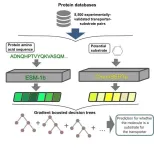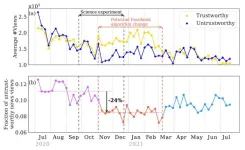(Press-News.org) (Boston)—Stroke related to large vessel occlusion (LVO) is a leading cause of disability and death worldwide. Endovascular therapy (minimally invasive procedures like catheterization done inside the blood vessels) has transformed the management of these patients. In 2015, several randomized trials showed the benefit of endovascular therapy compared with medical management in reducing disability in some patients, most of whom had small core infarction and presented to an emergency department within six hours of symptom onset. Evidence for the treatment benefit has also been extended to patients presenting within 24 hours of symptom onset, along with patients with large ischemic core infarct, and patients with basilar artery occlusion.
However, ongoing knowledge gaps remain including: an understanding of which patients with large ischemic infarct are more likely to benefit from endovascular therapy; the role of endovascular therapy in patients who present with low stroke severity scores on the National Institutes of Health Stroke Scale (NIHSS) or have medium or distal vessel occlusion (blood blockage); and optimal management of patients with underlying intracranial atherosclerotic disease.
In a review article in the journal Lancet, researchers from Boston University Chobanian & Avedisian School of Medicine and international collaborators examined the rationale of recent randomized trial designs and results that have proven the benefit of endovascular therapy, including reviewing current devices and addressing ongoing areas under study.
“Our paper is a contemporary update of the role of endovascular therapy (clot retrieval, rescue stenting) in the treatment of patients with acute ischemic stroke as well as patient selection criteria,” says corresponding author Thanh Nguyen, MD, professor of neurology, neurosurgery and radiology at the school.
Using a Medline database search, the researchers reviewed randomized clinical trials from 2015-24 that compared endovascular therapy to medical management for large vessel occlusion stroke. Medical management included thrombolytic drugs (drugs that would melt a blood clot), blood pressure medicine, and vascular risk factor management. They found randomized trials using a new generation of devices unequivocally confirmed the benefit of endovascular therapy over best medical treatment in selected patients.
They also found patient selection for endovascular therapy could be summarized by clinical and imaging criteria with a minimalist approach based on the evolving randomized evidence. “Most patients who present with a NIHSS score of higher than five and anterior circulation occlusion along with patients with an NIHSS of 10 or higher and basilar occlusions without extensive infarction on imaging, are good candidates for endovascular therapy up to the 24-hour window,” explains Nguyen, who also is a neurologist and Director of Interventional Neurology/ Neuroradiology at Boston Medical Center.
According to the Mohamad AbdalKader, MD, associate professor of radiology at the schoo and co-author of the article, a remarkable shift has occurred in the care of LVO patients in the past decade. “Advances from clinical trial data, endovascular therapy devices and techniques, expansion in the indication for endovascular therapy and lowering of imaging barriers to endovascular therapy selection have improved our understanding of how to optimize the care of these patients,” adds AbdalKader who also is a diagnostic and interventional neuroradiologist at Boston Medical Center.
These findings appear online in the journal Lancet.
https://www.thelancet.com/journals/lancet/article/PIIS0140-6736(24)01410-7/fulltext
Note to editor:
TNN is a member of the advisory board for Aruna Bio and Brainomix; has received a research grant to institution from Medtronic; is the Associate Editor of Stroke; is a member of the data and safety monitoring committee of the SELECT2, TESLA, and ENDOLOW trials; is the President of Society of Vascular and Interventional Neurology; and is the co-principal investigator of the SUMMIT MAX and PICASSO trials. UF reported research support of the Swiss National Science Foundation and the Swiss Heart Foundation; reported research grants from Medtronic (for the BEYOND SWIFT and SWIFT DIRECT trials), Stryker, Rapid Medical, Penumbra, and Phenox (for the DISTAL trial); reported consultancies for Medtronic, Stryker, and CSL Behring; participation in an advisory board for Alexion/Portola, Boehringer Ingelheim, Biogen, and Acthera; is a member of a clinical event committee of the COATING study (Phenox) and a member of the data and safety monitoring committee of the TITAN, LATE_MT, and IN EXTREMIS trials; and reported presidency of the Swiss Neurological Society. All fees related to UF’s declaration of interests are paid to institutions. UF is President-Elect of the European Stroke Organization. SN discloses stock options for Brainomix and was a speaker with Bayer, Boehringer Ingelheim, and Pfizer. ZM was principal investigator of the the ANGEL ASPECT trial and discloses that the trial was supported by grants from Covidien Healthcare International Trading (Shanghai), Johnson & Johnson MedTech, Genesis MedTech (Shanghai), and Shanghai HeartCare Medical Technology that were made to the institution. PK was the principal investigator of an unrestricted grant for investigator-initiated clinical trial, ENDOLOW, supported by Cerenovus; was the National Leader of the PACIFIC-Stroke clinical trial supported by Bayer; consulted for Lumosa and Basking Biosciences (for scientific advisory board participation); and was a one-time consultant for Shionogi. All other authors declare no competing interests.
END
Advances in endovascular therapy for stroke patients
2024-09-26
ELSE PRESS RELEASES FROM THIS DATE:
The Lancet Public Health: MMR vaccine remains the best protection against measles - modelling study in England suggests level of protection decreases slightly over time
2024-09-26
The Lancet Public Health: MMR vaccine remains the best protection against measles - modelling study in England suggests level of protection decreases slightly over time
The MMR vaccine remains highly protective against measles for life, protecting over 95% of vaccinated individuals from measles.
Most measles cases in England are in unvaccinated children and young people, but the proportion of measles cases in people who received two doses of the MMR vaccine has increased since 2010, especially among young adults.
New ...
Babies born after fertility treatment have higher risk of heart defects
2024-09-26
The risk of being born with a major heart defect is 36% higher in babies who were conceived after assisted reproductive technology, such as in vitro fertilisation (IVF), according to results of a very large study published in the European Heart Journal [1] today (Friday).
Researchers say the finding is important since congenital heart defects are the most common form of birth defects, and some of them are associated with life threatening complications.
The study also shows that the increase ...
New research confirms link between perceived stress and psoriasis relapse
2024-09-26
(Friday, 27 September 2024, Amsterdam, Netherlands) Innovative research has provided compelling evidence that perceived stress can directly trigger the relapse of psoriatic skin lesions.1 The study, presented today at the European Academy of Dermatology and Venereology (EADV) Congress 2024, is the first to scientifically validate this connection in vivo.
Psoriasis, a chronic skin condition affecting over 6 million people in Europe, is characterised by rapid skin cell production, leading to scaling and inflammation.2, 3 While it has long ...
Call to action: A blueprint for change in acute and critical care nursing
2024-09-26
PHILADELPHIA (September 26, 2024) – A groundbreaking article published in the latest issue of Nursing Outlook proposes a significant shift in how nursing care is measured within acute and critical care settings. This "Blueprint for Action" seeks to revolutionize current methods by recognizing the full scope of a nurse's work and its profound impact on patient outcomes.
"The current measurement systems fail to capture the essence of what nurses truly do," explains lead-author ...
Who transports what here?
2024-09-26
Transport proteins are responsible for the ongoing movement of substrates into and out of a biological cell. However, it is difficult to determine which substrates a specific protein can transport. Bioinformaticians at Heinrich Heine University Düsseldorf (HHU) have developed a model – called SPOT – which can predict this with a high degree of accuracy using artificial intelligence (AI). They now present their approach, which can be used with arbitrary transport proteins, in the scientific journal PLOS Biology.
Substrates in biological cells need to be continuously transported inwards and outwards across the cell membrane to ensure the survival of the cells and ...
Fitness loss through spontaneous mutations will not impact viability of human populations in the near future
2024-09-26
Spontaneous mutations tend to reduce fitness in populations of living organisms, but this erosion of fitness is countered by natural selection. This study uses the first mutation accumulation experiment in a mammal to show that even in the absence of natural selection, the rate of fitness loss should not be of concern, which is reassuring for humans.
#####
In your coverage, please use this URL to provide access to the freely available paper in PLOS Biology: http://journals.plos.org/plosbiology/article?id=10.1371/journal.pbio.3002795
Article Title: An estimate of fitness ...
Prize recognizes discovery of how cell population protects our airways – and keeps them clear
2024-09-26
For uncovering how a cell population helps ensure food, liquid and acid reflux are kept out of our airway – and instead sent to our GI tract – Laura Seeholzer is the winner of the 2024 Eppendorf & Science Prize for Neurobiology. Her findings, detailed in April in Science, have motivated her to study what’s happening with these cells in diseases where this critical protective reflex is compromised.
“These findings are crucial for understanding potentially life-saving reflexes that are activated in the airway, ...
Team led by UMass Amherst debunks research showing Facebook’s news-feed algorithm curbs election misinformation
2024-09-26
AMHERST, Mass. – An interdisciplinary team of researchers led by the University of Massachusetts Amherst recently published work in the prestigious journal Science calling into question the conclusions of a widely reported study — published in Science in 2023 and funded by Meta — finding the social platform’s algorithms successfully filtered out untrustworthy news surrounding the 2020 election and were not major drivers of misinformation.
The UMass Amherst-led team’s work shows that the Meta-funded research was conducted during a short ...
Science publishes eLetter on 2023 study by Guess et al., as well as response by Guess et al.
2024-09-26
In 2023, Science published the study, “How do social media feed algorithms affect attitudes and behavior in an election campaign?” by Andrew Guess et al. Now, Chhandak Bagchi and colleagues – in an eLetter that will appear on the 2023 study – state that the study’s “reporting and conclusions did not account for a series of temporary emergency changes to Facebook’s news feed algorithm in the wake of the 2020 U.S. presidential election that were designed to diminish the spread of voter-fraud misinformation. This issue may have led readers to misinterpret ...
Supreme Court ruling could strip protections from up to 90 million acres of US wetlands
2024-09-26
New interpretations following the recent Sackett v. Environmental Protection Agency (EPA) United States Supreme Court ruling could strip federal protections from up to 90 million acres of U.S. nontidal wetlands – nearly all that exist in the coterminous US – according to a new study. The findings reveal the potential scope and impacts of the regulatory changes and highlight the uncertainty introduced by the ruling. Enacted in 1972, the Clean Water Act (CWA) aims to restore and protect the quality of U.S. waters ...

